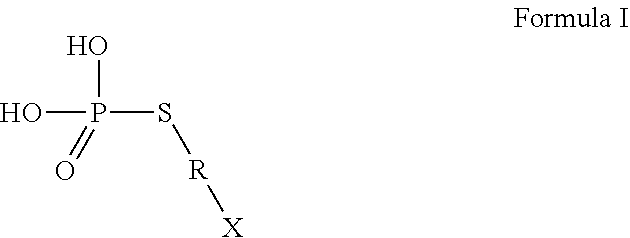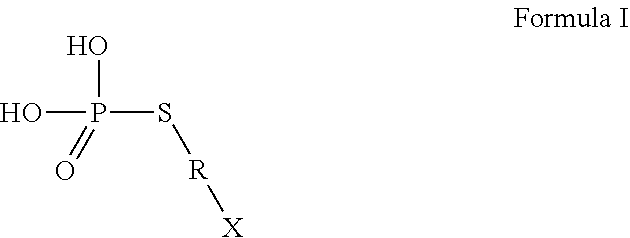Use of thiophosphate derivatives as skin depigmenting agents
a technology of thiophosphate and derivatives, which is applied in the field of skin depigmentation composition, can solve the problems of affecting the appearance of skin, and affecting the appearance of skin, and reducing so as to prevent and/or reduce the pigmentation of normal skin and/or normal hair, and reduce the number of melanocytes
- Summary
- Abstract
- Description
- Claims
- Application Information
AI Technical Summary
Benefits of technology
Problems solved by technology
Method used
Image
Examples
example 1
[0122]Six different topical preparations were made: The first preparation contained 5% (w / w) 2-di-isopropylaminoethanthiophosphate, the second preparation contained 5% (w / w) 2-diphenylaminoethanthiophosphate, the third preparation contained 5% (w / w) para-phenol-thiophosphate, the fourth preparation contained 5% (w / w) 2-di-isopropylaminoethanthiol, the fifth preparation contained 5% (w / w) 2-di-phenylaminoethanthiol and the sixth preparation contained 5% (w / w) para-thiophenol, in a hydrophil cream vehicle. These six topical preparations were each applied to three separate areas, each with a surface area of 9 cm2, on the upper back of six healthy volunteers with phototype IV. The hydrophil cream alone was applied on a separate area of the back of the same subjects and served as negative control. Applications were performed daily for six consecutive weeks. The skin lightening effect of the products was evaluated at the end of the study by a clinician blinded to the treatment identificat...
example 2
[0125]Two female volunteers diagnosed with melasma and resistant to different topical depigmenting formulations containing hydroquinone or cysteamine were treated once daily for six weeks by the topical application of a preparation containing 5% (w / w) 2-isopropylaminoethanthiophosphate in a hydrophil cream base. Significant improvement of melasma lesions was observed in both patients at the end of the study. The improvement was confirmed by the patients and was also quantitatively confirmed by a chromametric examination before and after the treatment. No side effects were observed in the patients.
example 3
[0126]Higher Depigmenting Efficacy in Comparison with Cysteamine-Phosphate
[0127]Cultured B16 melancytes were treated with 10 micromolar of cysteamine-phosphate or 2-di-isopropylaminoethanethiophosphate and the effect of each molecule on the inhibition of melanin synthesis was determined in comparison to the non-treated cells after 5 consecutives days of treatment.
[0128]It was shown that 2-di-isopropylaminoethanethiophosphate reduced the melanin content of viable B16 melanocytes to 85.5 microgram / ml compare to control which contained 105.7 microgram / ml of melanin (p<0.001, significant). While cysteamine phosphate at 10 micromolar concentration had no effect on the melanin content of viable B16 melanocytes.
Higher Efficacy in Comparison with Cysteamine and Cysteamine-Phosphate in vivo
[0129]2-di-isopropylaminoethanethiophosphate as well as cysteamine and cysteamine-phosphate were made into 5% (w / w) creams and were applied once daily to the skin of six human volunteers with phototypes II...
PUM
 Login to View More
Login to View More Abstract
Description
Claims
Application Information
 Login to View More
Login to View More - R&D
- Intellectual Property
- Life Sciences
- Materials
- Tech Scout
- Unparalleled Data Quality
- Higher Quality Content
- 60% Fewer Hallucinations
Browse by: Latest US Patents, China's latest patents, Technical Efficacy Thesaurus, Application Domain, Technology Topic, Popular Technical Reports.
© 2025 PatSnap. All rights reserved.Legal|Privacy policy|Modern Slavery Act Transparency Statement|Sitemap|About US| Contact US: help@patsnap.com



